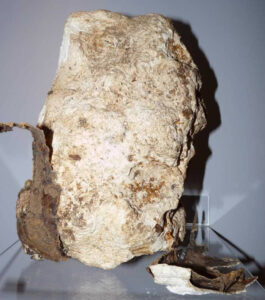A greasy business: the trade in Shetland butter
Bart Holterman, 18 December 2021
Among the commodities exported from the North Atlantic islands in the late Middle Ages and the Early Modern period, few are as enigmatic as butter. As rents and taxes were partly paid in butter on the islands, they frequently appear as a trade item in the dealings of the authorities or the church with foreign (German) merchants. However, the role of butter in the North Atlantic trade is not well understood.

On the Carta Marina of Olaus Magnus of 1539, barrels of butter are displayed near the monastery Helgafell in Iceland, indicating the significant butter production of the Icelandic church (see the header image of this blog). Magnus described in his 1555 Historia de gentibus septentrionalibus that salted butter was produced in Iceland “partly for consumption at home, but more particularly for barter with merchants”. It is indeed known that German merchants bought butter in Iceland, but but they imported butter to Iceland as well, which is puzzling. Probably, this was butter of a different quality, but the sources do not say much about it. Butter exports are also known for the Faroes in the late 16th century.
Where the relevance of butter as a foreign exchange product was probably limited in Iceland and the Faroes, it seems to have played a much more prominent role in Shetland and Orkney. Especially in the 17th century, there are frequent mentions of German merchants buying butter from Shetland sheriffs, lairds or tacksmen. On many occasions, they even entered into considerable debts for taking the butter to Germany.
This is remarkable, given that the export butter from Shetland and Orkney does not seem to have been of a specifically good quality. Farmers kept the better quality “meat butter” for home consumption, whereas the butter with which taxes and rents were paid was the low quality “grease butter”, full of hairs and dirt, unfit for consumption. According to Gordon Donaldson, it “was fit only for greasing wagon-wheels”. It was exactly this grease butter that was sold abroad. Already in the 16th century, it is known that salted Orkney butter was sold very cheaply in Scotland.
On a more closer look, it seems that the German merchants in Shetland were not so keen on buying the Shetland butter, even though they bought it in considerable quantities. Various letters of the 17th century tell about the negotiations of Shetland tacksmen and the servants of lairds with German merchants about the price of butter. For example, James Omand wrote to Laurence Sinclair of Brugh in 1640 that he could only sell the butter to the Germans for a lower price than expected. Two letters from Andro Greig to the Baron of Brugh from 1655 mention his dealings with Hamburg merchant Otto Make, who was not interested in buying butter for the reason that he could not get a good price for it on the German market. The letters of the tacksmen Andro Smith to his brother Patrick from the early 1640s also speak of the difficulties he had with selling the butter to the German merchants; he had to sell the butter in Leith in the end.
Even more explicit is a letter from David Murray to Andrew Mowat from 1682, in which Murray instructs Mowat to “use all possible means” to make the German merchants take the Shetland butter. This included threatening them, although he also presses him “to deall civellie with them”.
All in all, it appears that Shetland officials did not always have an easy time trying to sell the butter abroad. It also remains the questions why the Germans took the butter with them after all, especially since good-quality butter was produced in northern Germany as well, for example in East Frisia. Were the Germans exaggerating and only playing hard-to-get to keep the prices low? Did they give in to the pressure that the Shetlanders put on them? Or did they perhaps feel obliged to take parts of the butter from their trading partners for fear of losing access to the much more profitable Shetland fish trade, even if they could only sell it at a loss? It seems that further research will be needed to solve this riddle.
References and further reading
Ballantyne, John H., and Brian Smith, eds. Shetland Documents, 1612-1637. Lerwick, 2016.
Donaldson, Gordon. Shetland Life under Earl Patrick. Edinburgh, 1958.
Fenton, Alexander. The Northern Isles: Orkney and Shetland. Edinburgh, 1978.
Holterman, Bart. The Fish Lands. German Trade with Iceland, Shetland and the Faroe Islands in the Late 15th and 16th Century. Berlin, 2020.
Comments